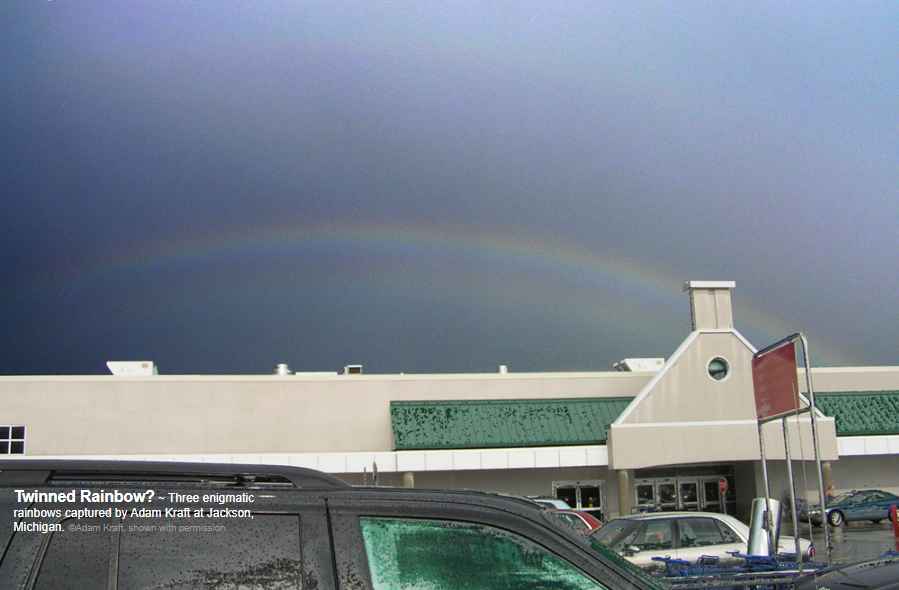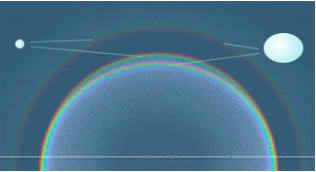OPOD Twinned Rainbow?
OPOD Twinned Rainbow?
Have you ever seen a twinned rainbow? It's a fascinating atmospheric phenomenon that captures the imagination of those lucky enough to witness it. Unlike a typical rainbow, which consists of an upper, normal secondary bow and a single primary bow, a twinned rainbow features two primary bows instead of one. This occurrence is incredibly rare, making it a captivating subject for atmospheric optics enthusiasts.
Typically, twinned rainbows are associated with heavy showers and stormy weather conditions. However, the interesting thing about the twinned rainbow captured by Adam Kraft in Jackson, Michigan, is that it appeared during a calm moment with relatively light rainfall. This unusual observation adds to the enigmatic nature of this phenomenon.
One possible explanation for twinned rainbows is the presence of reflections. In this particular case, there was only a small patch of water about 1 kilometer away from the camera, and it was not positioned exactly in line with the sun. Reflections from horizontal surfaces or wet sloping roofs are unlikely to produce the required position for a twinned rainbow. However, it's worth considering the possibility that a large roof area inclined at approximately 23 degrees could have contributed to the formation of the middle bow.
Another intriguing theory suggests that twinned rainbows may be created by two sets of raindrops with different shapes. For example, small drops and large drops could interact to produce this phenomenon. Surface tension causes small drops to maintain a spherical shape, while larger drops can become flattened due to air resistance or oscillation. If these flattened drops are optically even, they could generate an oval primary rainbow. The separation between the top of this oval primary rainbow and the normal bow depends on the degree of drop flattening.
To gain further insight into this theory, numerical simulations have been conducted by tracing rays through a mixture of spherical and flattened drops. Even with a modest flattening of just 2.5%, well-separated primary bows can be observed. Interestingly, the rays of the secondary bow pass between less distorted parts of the drops, resulting in a non-twinned appearance. However, it's important to note that distorted drops alone may not entirely explain the occurrence of twinned rainbows. A consistent level of drop flattening throughout an entire shower of raindrops is required, which seems unlikely.
While we have some possible explanations for twinned rainbows, there is still a significant level of uncertainty surrounding this phenomenon. The rarity of twinned rainbows makes it difficult to conduct extensive research and gather substantial data. Additionally, the appearance of supernumeraries, which are additional faint bands of light that can sometimes be seen on rainbows, adds further complexity to the understanding of twinned rainbows.
In conclusion, twinned rainbows continue to captivate scientists and enthusiasts alike due to their elusive nature. While we have put forward some intriguing theories, such as reflections and interactions between differently shaped raindrops, we are still far from fully comprehending the cause of this phenomenon. Further observations, research, and numerical simulations are needed to shed more light on the enigma of twinned rainbows. So, keep your eyes peeled for these rare and mesmerizing displays in the sky, and perhaps you'll contribute to unraveling their mysteries.

Twinned Rainbow? ~ Three enigmatic rainbows captured by Adam Kraft at Jackson, Michigan. ©Adam Kraft, shown with permission.
Three bows. An upper, normal, secondary bow and two primaries where there should only be one. The lower bows could be a �twinned� bow. If so this is the clearest and most widely separated example that we have.
Twinning is rare. It is mostly associated with heavy showers, sometimes with hail, during windy, stormy weather. But it was calm when these images were taken with the rain not particularly heavy. All the bows appeared for only a minute. Sunlight at the camera location was weak. The early evening sun was 24.7� high.
Could the bows be made by reflections instead? There was only a small patch of water 1 km away and not quite sunwards of the camera, none anti-sunwards. Anyway, sunlight reflected from horizontal surfaces cannot produce a bow in the required position. Neither can wet sloping roofs unless - highly unlikely - the middle bow was from a large roof area inclined at ~23�.
The cause of �twinned� bows is not known. Ice balls or ice inside raindrops have been invoked but that improbably requires not hailstones but near optically perfect and transparent ice spheres.
Another explanation is that the bows are made by two sets of drops of different shapes, perhaps in spatially separate showers. Small drops and large drops would do. Surface tension keeps small drops tightly spherical, large drops are not so constrained and can be flattened by air resistance or even oscillate wildly. Flattened drops would (if optically even) give an oval primary rainbow. The separation between its top and that of the normal bow depends on the drop flattening. At right is a simulation made by numerical tracing rays through a mixture of spherical and flattened drops. The flattening is only 2.5% yet it gives well separated primaries. Secondary bow rays pass between less distorted parts of the drop and the secondary is not twinned. Gross enhancement of the Michigan images does not show a doubled secondary.
However, distorted drops are a less than entirely credible explanation. A whole shower of raindrops is needed with almost the same degree of flattening. Varied flattening would give at most a smudge of light. There are other problems including the appearance of supernumeraries.
We have unlikely explanations. But then twinned bows are unlikely too.
We are unsure.


Note: this article has been automatically converted from the old site and may not appear as intended. You can find the original article here.
Reference Atmospheric Optics
If you use any of the definitions, information, or data presented on Atmospheric Optics, please copy the link or reference below to properly credit us as the reference source. Thank you!
-
<a href="https://atoptics.co.uk/blog/opod-twinned-rainbow/">OPOD Twinned Rainbow?</a>
-
"OPOD Twinned Rainbow?". Atmospheric Optics. Accessed on November 23, 2024. https://atoptics.co.uk/blog/opod-twinned-rainbow/.
-
"OPOD Twinned Rainbow?". Atmospheric Optics, https://atoptics.co.uk/blog/opod-twinned-rainbow/. Accessed 23 November, 2024
-
OPOD Twinned Rainbow?. Atmospheric Optics. Retrieved from https://atoptics.co.uk/blog/opod-twinned-rainbow/.